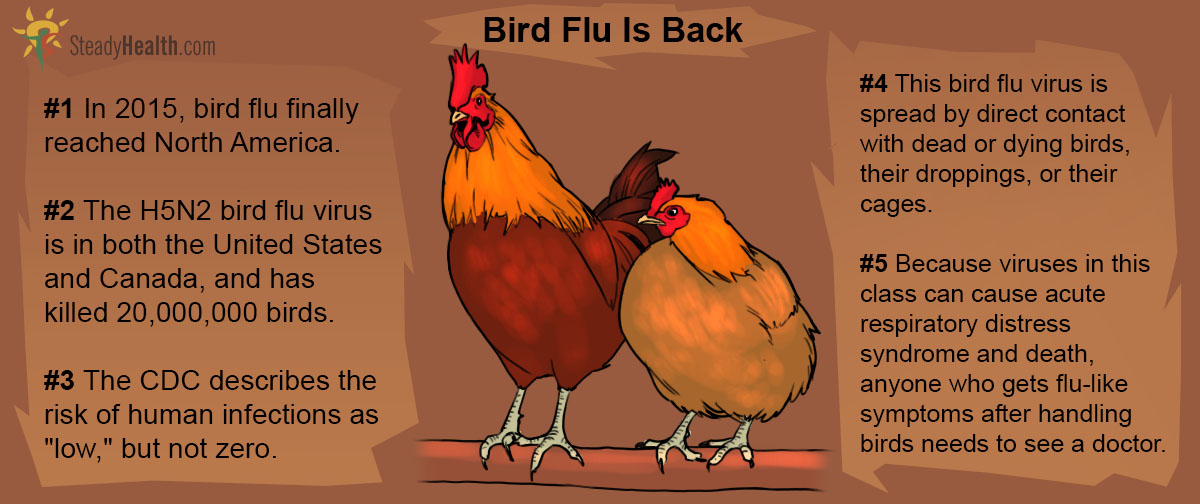Bird flu news has largely disappeared from public awareness in the USA. The Asian H5N1 influenza virus, which killed 440 of the 826 people who have contracted it since 2003, is no longer a public health concern. An offspring of the H5N1 virus with genes from milder forms of bird flu, however, has killed 20,000,000 chickens and turkeys in just three states, Iowa, Minnesota, and Wisconsin since the beginning of 2015. Poultry workers are being required to wear protective suits and are being asked to take Tamiflu, a medication designed to forestall the earliest symptoms of flu.
Basic Bird Flu Facts
The new avian influenza viruses are in the H5N1, H5N8, and H5N2 categories. The "H" and the "N" in the name of a flu virus refer to the antigens they produce, the particles they emit that interact with the human immune system. There are 17 different H antigens and nine different N antigens.
H5N1 is the bird flu virus that caused an epidemic in 2009. It had become much less lethal, which enables it to travel much more widely. Exceptionally lethal viruses tend to kill off their hosts before they can infect others. There is a vaccine for H5N1.
H5N8 is another virus that can infect both birds and people. Its symptoms are usually "flu like" in people. It just causes sniffles, mild coughing, headaches, and a low fever.
H5N2 is the main virus spreading through the Midwest now. It is not known to cause symptoms in humans. It affects many different kinds of birds, usually causing only mild symptoms. However, some strains of H5N2, like those now epidemic in the Midwest, can kill commercial poultry en masse.
There is a flu vaccine for birds. It's used in China to protect flocks of chickens, ducks, and geese. However, there is no vaccine for H5N8 and H5N2 for people that covers the strains going around in the US right now.
How Is Bird Flu Spread?
It is important to understand that the current outbreak of bird flu is an epidemic (regional outbreak), not a pandemic (global outbreak), and it is currently limited to birds. However, the US government is sufficiently concerned that H5N2 could become a permanent problemin the United States that it has assigned 365 US Food and Agriculture Department workers to controlling the infection's spread.
Bird flu is spread when birds (or people) come in contact with the droppings, saliva, or nasal secretions of infected birds. The virus can also linger on the surfaces of cages. People can contract the virus when they handle dead birds, sick birds, bird manures, or when they prepare birds to be eaten.
See Also: Bird Flu in the News Again: Is a Springtime Epidemic Possible?
It takes more than casual contact for humans to come down with bird flu. Usually repeated exposure to large numbers of dead birds or large amounts of poultry manure is required. Human-to-human transmission of the disease, at least in its current form, has never been reported.
What Are The Symptoms of Bird Flu? And What Can You Do If You Get It?
If you work with birds, symptoms of flu may be a sign of bird flu. If you don't work with birds, you are not likely to get bird flu. Contagious birds transmit the virus through their feces in large amounts. If your job doesn't require you to deal with chicken droppings, chances are you won't get this strain of bird flu.

The first symptoms of bird flu are:
- Fever,
- Chills,
- Sore throat, and
- Muscle aches,
much like any other kind of flu. The majority of people who are exposed to H5N2 won't even develop these relatively mild symptoms. Their immune systems will be able to deal with the virus. However, in other outbreaks, bird flu viruses have mutated into forms that can cause acute respiratory distress syndrome, a viral pneumonia that can quickly cause death even if aggressively treated.
For that reason, if you think there is any possibility you have been exposed to bird flu, especially if you develop flu-like symptoms after working with dead birds during summer weather, you should seek medical care at once. Your family and other people with whom you share your home should wipe down any surfaces that could be contaminated with your bodily fluids in any form, and you should avoid sharing glasses, towels, and bedding until the doctor tells you it is safe.
The US government is sufficiently concerned about this bird flu outbreak that the Centers for Disease Control (CDC) has tapped its emergency supplies of Tamiflu (oseltamivir). Poultry workers cleaning up the dead birds or killing sick birds have been asked to take Tamiflu to prevent flu symptoms, and possibly to prevent them from spreading the virus to other people. The CDC has not recommended the use of Relenza (zanamivir) because as an inhaled medication, it can make respiratory distress worse.
Should you worry about catching this latest strain of bird flu?
The H5N2 outbreak had spread to a total of 12 states in the United States, Arkansas, Idaho, Iowa, Kansas, Minnesota, Missouri, Montana, North Dakota, Oregon, South Dakota, Washington and Wisconsin, and also in Ontario, Canada, by the end of April, 2015, but CDC officials describe the risk of a human epidemic as "low." That is because some genetic markers associated with the most highly infective strains of the last bird flu virus, H5N1, aren't found on H5N2.
See Also: H1N1 Vaccine Side Effects: Reactions to Swine Flu Vaccine
Summer warmth and increasing sunlight may kill the virus, so that the current outbreak is naturally contained by the middle of 2015, even without mass dispersal of bird flu vaccines to stop bird flu spread. However, it's a good idea to stay alert to bird flu symptoms, especially if you work directly with chickens or turkeys in the poultry industry.
- P.J. Huffstutter and Julie Steenhuysen. Increased Human Protections Offered as H5N2 Outbreak Spreads. Reuters Health. 27 April 2015.
- Julie Steenhuysen and Meredith Davis. Risk Low for Human Infection From U.S. Strains of Bird Flu -CDC. Reuter's Health. 23 April 2015.'Mind map by SteadyHealth.com
- Photo courtesy of photologic via Flickr: www.flickr.com/photos/fotologic/124790416



Your thoughts on this